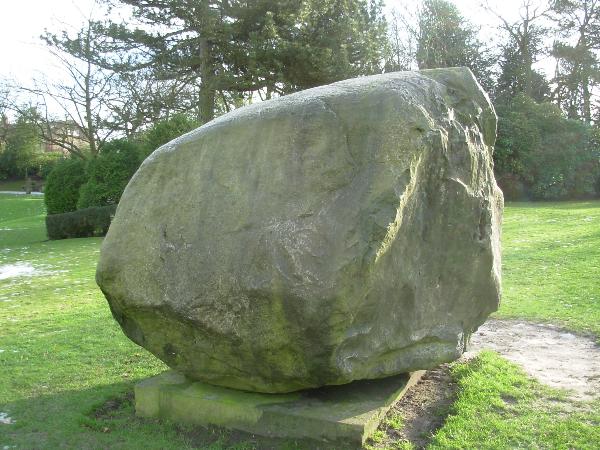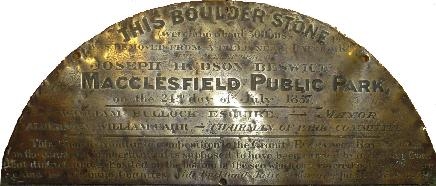West Park Boulder
Stone
With the kind permission and help of Cheshire
East Council

This is a big rock that came to rest in West Park
Macclesfield but what is it? where did it come from? but most
importantly, how did it get here?
What is
it?
It is a type of rock called Granite, an igneous
rock that forms as magma and cools far beneath the earth's surface.
As it cools very slowly this allows crystals of the four main
minerals that it comprises to grow large enough to be easily seen
by the naked eye. These are Feldspar, Mica, Quartz and Hornblende.
It is rather heavy, having a density of 2,691 kg/cu.m or 2.691
times heavier than the equal volume of water would be.
Where did it come
from?
It began its journey near Ravensglass in Cumbria
about 150 kilometres to the north west, we know this because its
mineral composition can be traced to the parent bed rock. So how
come its here in Cheshire where all the other rocks around and
about are sandstone.
How did it get
here?
The reason it came to be here is because of the ice
age when glaciers up to 3km thick covered most of Great Britain,
these colossal rivers of slowly moving ice showed little mercy for
just about anything that got in their way and this rock was one of
their victims, either having being scoured from the bed rock or
landing on it as the result of a rock fall. It was carried by the
glacier to the point where it was deposited deep underground in the
glacial clay around 12,500 years ago.
Geologists call this rock a "Glacial Erratic".
Erratics take their name from the latin word "errere" which is
"Error", "Wanderer", Something that shouldn't be there as they have
a characteristic very different to the rocks upon which they came
to rest when, for whatever reason, the glacier dumped them. They
were once thought to have been evidence of a great flood, which in
a way they are!
Glaciers contain rocks varying in size from gravel
to massive boulders all grinding against each other and the
underlying bedrock as it moves slowly along, this abrasion causes
glacial striations which can be seen as multiple groves and
parallel lines worn into the rock.
Polished and rounded by this action, they have a
very smooth feel to them and this boulder having been buried for
thousands of years shows very little sign of the weathering that is
usually found on glacial erratics that have been exposed. This
makes it possible to see the faint striation marks left on it by
the glacier.
But that was just the first part of its journey, in 1857 it was
rediscovered during excavation work in a field near to Oxford Road
Macclesfield. The Victorians, being interested in this sort of
thing and having a brand new public park just up the road decided
to display it there by mounting it on a plinth and putting a brass
plaque on it. They had to use a team of eight horses to move it the
final kilometre of its journey to the park, a lot more effort than
the glacier used to bring it from Cumbria.


West Park
In 1850 Councilor John May announced the proposal that a Public
Park be created in Macclesfield. This proposal caught the
imagination of the working people as no other public undertaking
had done before and within three weeks of its introduction £300 had
been collected in small amounts from 17,000 working people in the
town, which became known as “The Pennies of the
Poor”.
The park was opened in 1854 and is just over 15 acres with
plenty of facilities including:-
- Children’s Play Ground & Toddler's Play Area
- Bowling Green
- Café
- Barbecue area
- Museum
- Ornamental Gardens
- Picnic area
- Skate Board Area
- Tennis Court
- Toilets
The entrance is on Prestbury Road, Macclesfield and
Limited parking is available within the park.
Opening times are 8.30 am to
Dusk (5pm Winter)
In order to log this
EarthCache:-
This boulder has been rounded, smoothed and polished by a
glacier and the plaque says that it weighs around 30 tonnes, but it
is rather an irregular shape. If the glacier had rounded it so much
that it formed a perfect sphere then its weight could easily be
determined by taking one measurement and doing a bit of maths using
a couple of known constants. You can give it a go and be fairly
accurate with your results. How close were the people who estimated
the weight back in 1857 to your findings.
A 10 metre long tape measure will be needed and don't worry if
your concerned about doing the maths as help is available by using
the on line calculator or you can
do it the long way by using the
formula and researching the densities of the main component
minerals and substituting them for the given density of
granite.
Email me through my GC.com profile with the answers to the four
following questions, please do not put the answers in your
log:-
- Measure the circumference of the boulder in metres.
- Use your measurement from question 1 to calculate the weight of
the boulder.
- Which of the four main minerals found in granite is the most
dense, use your answer from question 1 to calculate what the
weight of the boulder would be if it were composed of just that
mineral.
- One part of the boulder has been worn very flat by the glacier,
here you can see the parallel lines that are glacial striation, the
result of the abrasive action of the glacier, in any 10cm wide part
count the number of lines you can see.
(Optional) but still worth
doing:-
- Have a close look at the boulder, see how highly polished parts
of it are and how smooth it feels
- Calculate
the weight of the boulder using different measurements to the one
you took for question 1 to see how the weight varies with even the
slightest of changes in circumference.
- Include a picture in your log of yourself and your GPSr (or
only the GPSr if your’re camera shy) with the boulder in the
background as additional proof that you visited the location.